

Over the past week or two, there has been severe flooding in Australia, Brazil, Sri Lanka, and the Phillipines, but all we’ve shown on the Earth Observatory is the flooding in Australia. Why? Here’s a sampling of images of Rio de Janeiro since January 12:
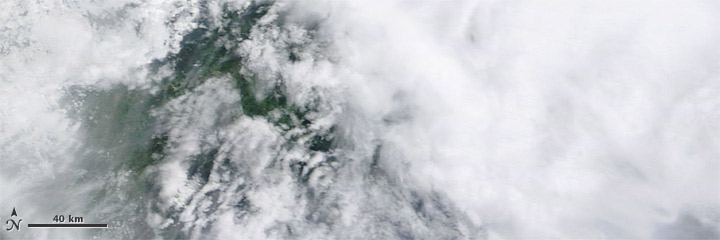
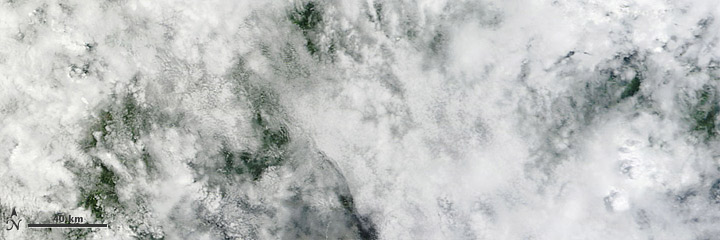

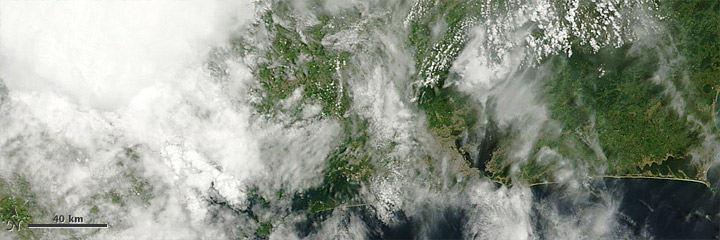
Earth is cloudy. Especially in the tropics. Even more especially when there’s enough rain to cause flooding. The satellite imagery we have easy, fast, and free access to (for example, check out the twice daily MODIS imagery of São Paulo) is primarily based on visible and infrared light, which can’t penetrate clouds, so for many floods we can’t show anything useful.
In addition, the damage in Brazil, Sri Lanka, and the Philippines was caused by flash floods, landslides, and debris flows, which are all much smaller scale than the rivers overflowing their banks near Brisbane. In satellite imaging there’s a tradeoff between spatial resolution (detail) and temporal resolution (frequency) so there are fewer opportunities to capture the high resolution data necessary to show relatively localized events. To view something like a landslide, we have to have both a break in the clouds and the opportunity to aim a high resolution sensor. Which occurred this morning:
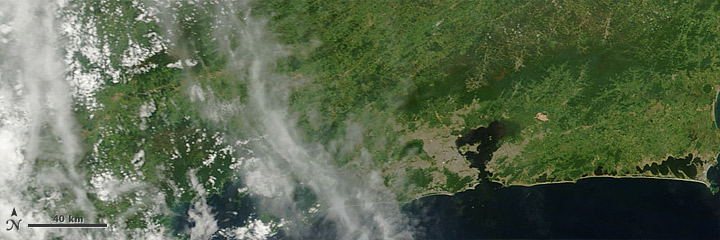
With clear skies and an overpass of Earth Observing-1, we may have an image of Teresopolis, Brazil by tomorrow.
P.S.: Despite the dispassionate view afforded by satellites, my thoughts go out to the victims and their families.
Update: For some reason the satellite never acquired the data, and the next viewing opportunity won’t be for another few days.
I got back from AGU last Saturday, picked up the pups from the kennel, and now I’m getting things together here so I can go on vacation right after Christmas.
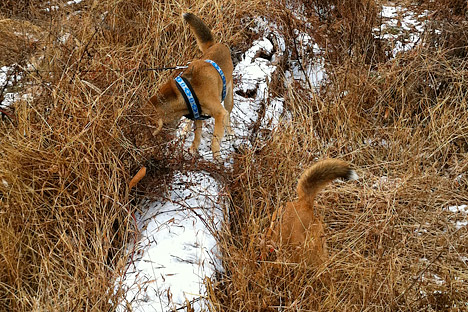
As always it’s an overwhelming conference—there’s probably 1,000 posters on the floor at any given time, and at least ten simultaneous sessions. I got some very good ideas wandering through the posters (a map of ice flow speed for all of Antarctica, research on a paleo lake in Kenya, and a global dataset of limiting factors for tree growth being highlights) that I’ll hopefully be working on in the New Year. Tuesday’s special session on communicating climate change was also worthwhile (and packed). I think both my talks went pretty well, even if I can’t pronounce Eyjafjallajökull—despite professional help from a native Icelandic speaker. One conclusion we came to in the visualization session: it would be helpful for AGU to start promoting good visualization techniques. I plan on following up on that, hopefully I’ll have more to say soon.
A few words of advice for poster presenters (I originally planned on showing some examples of good and bad design, but chickened out). White space is good: try not to jam your poster full of every last detail of your research. Do not use Comic Sans (avoid it on slides, too). Seriously. Your research may be groundbreaking, but it’s hard for me to take you seriously if you try to be cute. Especially since the new Microsoft typefaces that ship with Vista, Windows 7, and recent versions of Office are very, very good. Make your graphics big. Avoid the rainbow palette. (I’ll have more to say about this—a lot more—soon. It was a big part of my Eyjafjallajökull talk.) Print up a one-page summary to distribute. Include a conclusion, written for non-experts. Your poster will be up all day, you’ll only be there for an hour or two. Finally: if you can figure out a way to add multimedia, do it. Rolf Hut of the Delft University of Technology had an amazing, temperature-sensing interactive LED display:
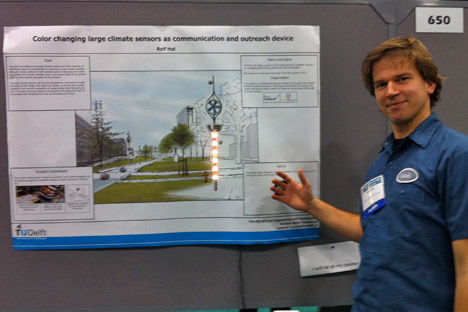
If anyone is going to the AGU fall meeting in San Francisco and would like to know more about the Earth Observatory and/or data visualization, I’ll be giving two talks, both on Thursday the 16th:
The Communication Strategy of NASA’s Earth Observatory at 8:45 a.m. in session ED41D. Climate Change Adaptation: Education and Communication I.
Visualization Case Study: Eyjafjallajökull Ash at 1:55 p.m. in session ED43B. Visualization of Geophysical Processes for Science, Education, and Outreach II.
I’ll be there all week, so if you want to meet to chat (or know of any sessions you think I’d be interested in, or excellent restaurants), send a message to the “Design Feedback” topic on our contact page, and I’ll get back to you.
One of my (many) pet peeves in data visualization is vertical exaggeration. For example, here’s a 3D rendered view (from the south looking north) of Mount Etna:
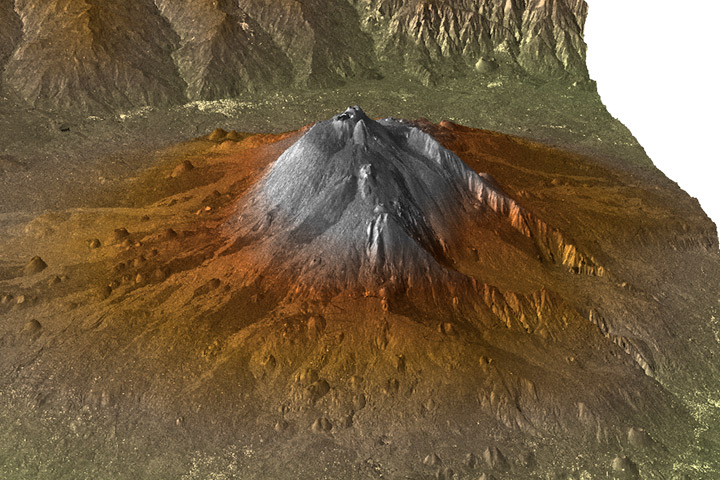
Compared to the real thing, photographed from the International Space Station (from the north looking south):
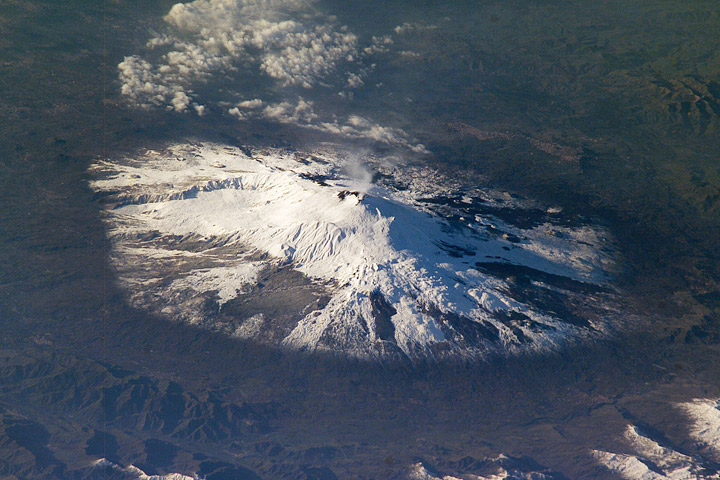
The 3D view is scaled so the volcano appears much higher than it does in real life—perhaps four or five times higher—but it’s impossible to tell since the caption doesn’t say. My big problem with this is that Etna looks like a classic, steep-sided stratovolcano (like Mount Fuji), rather than a complex mountain formed from a combination of viscous lavas (typical of stratovolcanoes), fluid lavas typical of shield volcanoes (like the Hawaiian Islands), and collapses (like Mount St. Helens).
At least it’s not as bad as the infamous image of Maat Mons on Venus, which has a staggering vertical exaggeration of 22.5 times (Maat Mons is actually shaped more like a wad of gum on the sidewalk, not Mount Rainier):
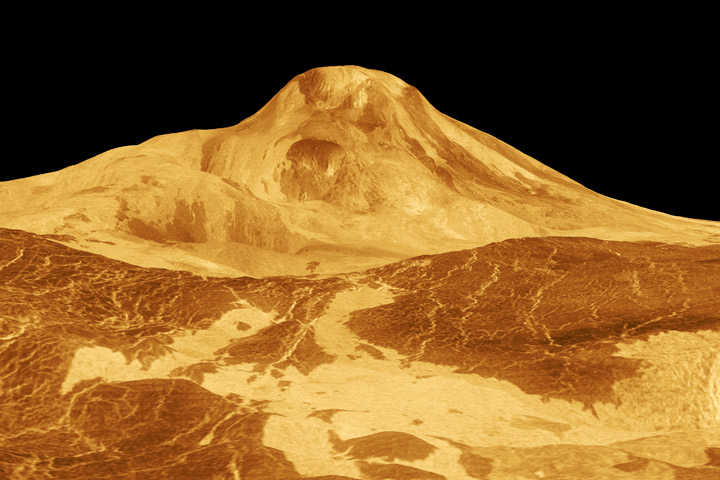
Why does it matter? Because topography gives clues to the underlying geology and processes that form a landscape. For example, the angle of the walls of the Grand Canyon is determined by the rock type: hard rocks form cliffs, soft rocks form slopes. The vertical granite walls of Yosemite are composed of hard granite that resisted the erosion of ice age glaciers.
The reason for the shape of mountains on Venus is perhaps even more interesting. It’s so hot on the surface (465°C) that most of the rocks creep: over time solid materials deform under their own weight. This limits the height of mountains on Venus, and ensures that steep slopes—if they exist at all—are extremely rare (and likely indicative of active tectonics). The vertical exaggeration used in images of Venus’ surface obscures some of the fundamental processes that shaped the planet.
One final note: If you absolutely have to use vertical exaggeration, at least indicate that fact in the caption, or even better, include a scale on the image itself.
[Credit where credit is due: I first learned of Maat Mons from one of Edward Tufte’s lectures on data visualization. Tufte himself cited the “Flat-Venus Society” and NASA’s David Morrison.]
In the process of researching captions I can run into some amazing stuff, like this photo (taken yesterday) of incandescent rocks arcing through the sky during the collapse of a lava bench near Kilauea:
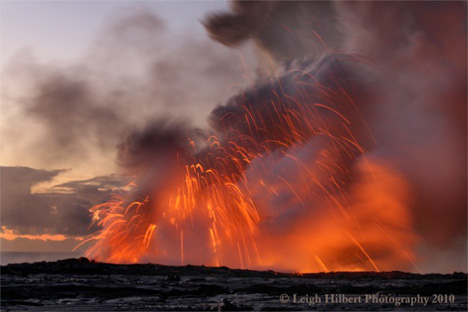
The USGS explains: “lava can instantly transform seawater to steam, causing explosions that blasts hot rocks, water, and molten lava fragments into the air.” No kidding.
Leigh’s site, Hawaiian Lava Daily, has some of the best photos of Hawaii’s active lava flows I’ve ever seen. He also pointed me to this description and photo essay of the last moments of Gary Sleik’s house in Kapana Gardens—destroyed by lava in July—as well as a recent “wake” for the house. An intimate look at events that can appear quite impersonal from space.
I found these while researching the caption for a satellite image of lava flowing into the ocean on Hawaii’s Big Island. Large versions (and more photos) on the USGS Kilauea Images site.
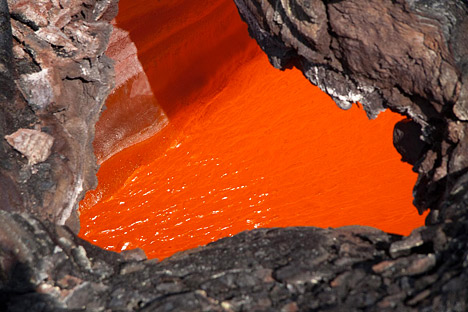
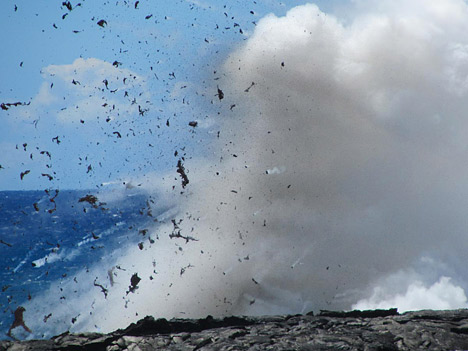
North and South America, August 9, 2010.
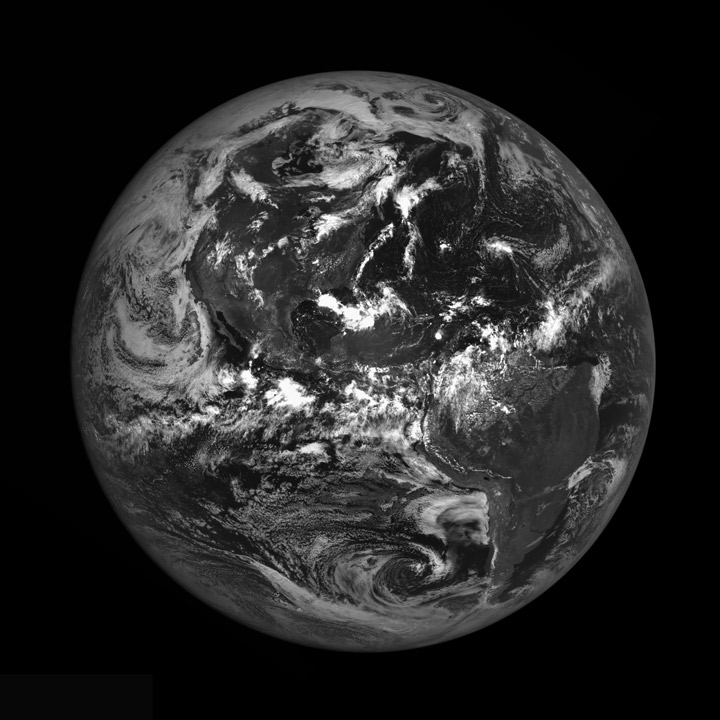
By Mark Robinson, LROC Team.
As LRO orbits the Moon every two hours sending down a stream of science data, it is easy to forget how close the Moon is to the Earth. The average distance between the two heavenly bodies is just 384,399 km (238,854 miles). Check your airline frequent flyer totals, perhaps you have already flown the distance to the Moon and back on a single airline!
LROC’s most recent Earth calibration sequence captured a magnificent view of the Americas with only minimal cloud cover. Contrast the current image with the NAC view taken last June, which revealed much of central Asia.
The Moon is a spectacular sight in the nighttime sky. Now imagine the Earth from the Moon, four times larger, a delicate blue, and it does not rise nor set. To astronauts, the Earth is a constant companion, at least on the nearside. Of course, on the farside you can never see the Earth.
The overarching goal of the LRO mission is to obtain the data needed to enable engineers and scientists to design the hardware and instruments to pick up lunar exploration where it was paused in December of 1972, after Apollo 17. LRO has now collected these data, so we are ready to move along the path of returning to the Moon! Will designs for lunar habitats include Earth windows? Certainly a human factor to consider! Are there any adverse psychological effects for future lunar explorers on the farside with no Earth overhead? What do you think? For now, we are happy to occasionally snap an image of the Earth as the NAC collects routine calibration data.
View the full-size image (4400 by 440 pixels) on the LROC gallery.
A little bit off topic, but worth it. Time lapse photography of clouds & fog in the Bay Area. Watch to the end, it’s worth it. From the Mother Jones Blue Marble blog.